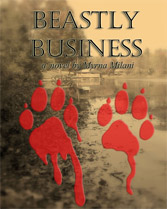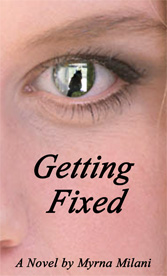I’m an avid reader and invariably take at least one book with me whenever I travel and always am reading at least one at home. During the years when I traveled a lot I read a lot of entertainment fiction, primarily because the average airport and plane doesn’t lend itself to anything more heady. Naturally any book that contained animals captured my fancy, but more often than not I found the results less than satisfying. This occurred because I prefer books written from the inside out rather than the outside in. By that I mean that I’d rather read a less significant book (strictly in the literary sense) written by someone working in a particular field, such as forensics or medicine, than one by a professional writer describing the activities of those working in that field. This probably goes back to something the professor of a creative writing course I took in college would say over and over again: “Write about what you know and love best.”
So much of the entertainment fiction I read that contained domestic animals either superficially dismissed them or presented them as cloyingly cute and highly anthropomorphic. Meanwhile human relationships with animals were presented as either black or white instead of embodying the full spectrum of colors and shades I knew so well. Because of this, I decided to write stories that reflected a deeper knowledge of animal behavior and the bond for those who prefer more realism in their animal-related fiction. The following books represent the results of that work.
Although I don’t consider the subject matter of any of these books any more shocking than anything I’ve read relative to humans I also realize that some people, including many publishers, maintain a much stricter standard regarding what constitutes acceptable human-animal interactions and the treatment of animals in literature. That, in and off itself, constitutes such a bizarre paradox in our society that I naturally explore in one of the later mysteries!
For myself, though, I believe that the bond represents one of the most potent forces in nature and, as such, it naturally possesses the potential to precipitate the very worst as well as the very best in human and animal alike. I also believe that if we truly love animals, we must be willing to explore the full range of animal behavior and human-animal relationships, even those we’d prefer to avoid. Without that willingness, we risk being more in love with what animals symbolize to us instead of who and what they really are.
 eBook available at
|
Beastly Business
As an avid reader and lover of mysteries, it seemed to me that this genre would lend itself very well to the exploration of some of the more controversial aspects of the human-animal bond, and Beastly Business represents the first of such a series. Although it has yet to find a mainstream publisher, I offer it here because the majority of rejection letters I received regarding it didn’t fault the writing; they faulted the subject matter which editors viewed as too controversial and/or difficult to market because it doesn’t support the dismissive or romanticized view of domestic animals. However, those who have read my fiction tell me they enjoy it because they’re fascinated by all aspects of the human-animal bond, not just the warm fuzzy ones.
This first book of the series introduces veterinary ethologist, StClair Upton, and her quasi-partner Chandler McCarthy, a molecular biologist who writes questionable, but best-selling action fiction and maintains shadowy connections to the law enforcement community. The book centers around StClair’s diminutive client, Monica Sonco who admits having a relationship with her pit bull that StClair knows most people would consider way beyond the fringe. However before StClair can help the young woman, her mangled body is discovered with the blood-covered dog standing over her. The plot thickens when StClair discovers that her former client also shared her vacation cottage with a stolen pygmy goat carrying an extremely valuable human gene splice.
Who killed Monica Sonco? What happened to the goat?
As StClair attempts to discover who killed her client, she finds herself relentlessly drawn into a high-tech animal conspiracy that takes her so deep into the dark recesses of the human-animal bond, she fears she may never find her way out.
A Killing Frost
During the period when I reviewed A Killing Frost before posting it on this site, a friend and I got into what I suppose some would consider a bizarre discussion bemoaning the demise of the nervous breakdown. We both remembered instances from our childhood in which people would succumb to this nebulous condition and disappear for several weeks or months of rest and recuperation. In his book The Youngest Science: Notes of a Medicine-Watcher, distinguished scientist and physician Lewis Thomas describes an incident that sums up the role of human caring in the treatment of this now nonexistent medical phenomenon. A wildly hallucinating piano teacher came into his physician-father’s office then left in a panic before the physician returned. Thomas’s mother, a nurse, treated the problem on her own, visiting the woman twice daily with trays of hot food and talking to her through the locked door of her apartment. This went on for several months until the woman recovered and resumed her successful career. No one in the town ever knew anything beyond that the woman was ill and that Thomas’s mother was taking care of her.
Theoretically, the disappearance of the nervous breakdown in favor of a plethora of more specific diagnoses stands as a triumph of modern medical science and technology. However, I bet a lot over-worked, stressed folks would gladly trade in their Prozac prescriptions for a neighbor like Thomas’s mom who would support them with good food, a good ear, and grant them the privacy to make peace with their own demons and emotions in their own way and in their own time.
Drug abuse and addiction rank high on the list of international health and social concerns. At the same time, the ability to alter another’s physiology and behavior with drugs sits smack in the center of modern medicine. From my own experience in both veterinary medical and behavioral practice, I know that giving drugs that change others carries its own special rush. That awareness, coupled with the increased use of mood-altering drugs on animals, led me to explore the effects on the dispenser as well as the recipient: Could the rush that comes from controlling others with drugs “for their own good” get out of hand? I contend that it could, and A Killing Frost provides a fictional account of how it might happen.
The book opens with StClair Upton reading McCarthy’s latest thriller on a plane following a seminar in Denver. Thanks to a canceled connecting flight between New York and New Hampshire she meets British biochemist, Sara Klafin, who over a period of days makes what amounts to a confession that involves two murders and Cold War mind-altering drug experiments that continued long after the program supposedly ended. When StClair discovers that Sara plans to meet the only person capable of continuing the research at Hanover College where both StClair and McCarthy now function as Wentworth Fellows, and that Sara has possible ties to McCarthy as well as other members of the faculty, life becomes very complicated for the peace-loving veterinarian. It becomes even more complicated when Sara’s dead body winds up in the bottom of a scenic Vermont gorge, StClair’s dog almost dies from a drug-filled dart from a blowgun, and a drug-crazed maniac attacks StClair with a scalpel. As McCarthy becomes increasingly convinced that a past indiscretion has come back to haunt him, StClair becomes increasingly convinced that political intrigue plays little or no role in the case. Unfortunately, the more intense the couples’ emotional affect on each other becomes, the more difficulty StClair experiences separating her own feelings from those of her suspects’, an error that almost costs her her life.
Getting Fixed
I wrote Getting Fixed as a stand-alone novel exploring how some people use animals to work through significant human-human issues they might otherwise avoid. Using the “Write from what you know” dictum, the main character here is also a veterinarian. However, unlike essentially normal StClair Upton, Khali Shackleford has major problems. In addition to an upbringing that includes emotional and sexual abuse, she’s also experienced a failed marriage and career burn-out. Given this background, it comes as no surprise that she gravitates toward animal rather than human companionship, and that her relationships with animals differ from those of more stable individuals.
A good friend assures me that no publisher would touch Getting Fixed because it includes a traumatic animal-related incident that will undoubtedly upset some animal lovers. I realize this because I consider myself an animal lover and the incident upset me when I wrote it and still upsets me when I read it. However I simply could not soften, let alone delete, that pivotal event because as every true animal lover knows, how we relate to animals does have consequences. Although miracles can happen, love does not always conquer all, animal love is not unconditional, and animals will suffer when we refuse to acknowledge this. To suggest less would mean buying into the romanticized vision of human-companion animal relationships that has led to the abandonment and death of countless pets. I simply couldn’t do that just to sell a book.
However, I don’t consider Getting Fixed a downer book at all. Rather I consider it an enlightening one that explores aspects of the bond familiar to all animal-lovers: the temptation to project our feelings and beliefs on animals, the seduction of rescuing someone (be that someone animal or human), the feeling of control that comes from keeping the saved individual safe, the feeling of failure that comes when we can’t. Although few people experience the dramatic events described in this book, I wrote it to explore that little bit of Khali in us all.

